Bridging the Urban-Rural Broadband Connectivity Gap using 5G Enabled HAPs Communication Exploiting TVWS Spectrum
by Habib M. Hussien 1,* ![]()
![]() , Konstantinos Katzis 2
, Konstantinos Katzis 2 ![]() , Luzango P. Mfupe 3
, Luzango P. Mfupe 3 ![]() and Ephrem T. Bekele1
and Ephrem T. Bekele1 ![]()
1 Addis Ababa Institute of Technology (AAiT), School of Electrical and Computer Engineering, Addis Ababa, Ethiopia
2 European University of Cyprus, Department of Computer Science and Engineering, School of Sciences, Nicosia, Cyprus
3 CSIR, NGEI, Pretoria, South Africa
* Author to whom correspondence should be addressed.
Journal of Engineering Research and Sciences, Volume 1, Issue 2, Page # 24-32, 2022; DOI: 10.55708/js0102003
Keywords: Antenna Radiation Pattern, High Altitude Platforms, IEEE 802.22, ITU-T P.452, TVWS
Received: 03 January 2022, Revised: 28 February 2022, Accepted: 05 March 2022, Published Online: 14 March 2022
AMA Style
Hussien HM, Katzis K, Mfupe LP, Bekele ET. Bridging the urban-rural broadband connectivity gap using 5G enabled HAPS communication exploiting TVWS spectrum. Journal of Engineering Research and Sciences. 2022;1(2):24-32. doi:10.55708/js0102003
Chicago/Turabian Style
Hussien, Habib M., Konstantinos Katzis, Luzango P. Mfupe, and Ephrem T. Bekele. “Bridging the Urban-Rural Broadband Connectivity Gap Using 5G Enabled HAPS Communication Exploiting TVWS Spectrum.” Journal of Engineering Research and Sciences 1, no. 2 (2022): 24–32. https://doi.org/10.55708/js0102003.
IEEE Style
H. M. Hussien, K. Katzis, L. P. Mfupe, and E. T. Bekele, “Bridging the urban-rural broadband connectivity gap using 5G enabled HAPS communication exploiting TVWS spectrum,” Journal of Engineering Research and Sciences, vol. 1, no. 2, pp. 24–32, 2022.
As with previous generations of mobile cellular networks, rural regions are projected to face financial and technological challenges in deploying 5G services. At the time, researchers all around the world are investigating the feasibility of utilizing TV White Spaces (TVWS). TVWS is an underutilized/unused section of television spectrum that might be used as a low-cost alternative to typical licensed wired/wireless broadband networks, as well as to bridge the broadband service availability gap between rural and urban regions. A feasible alternative is to deliver TVWS services via High Altitude Platforms (HAPs) for many developed and developing nations to deliver broadband services to a large proportion of their rural and low-income populations. This article examines the advantages of utilizing TVWS spectrum from HAPs as well as the challenges connected with this type of communication architecture. This article examines the advantages of leveraging TVWS spectrum from HAPs as well as the challenges that come with this type of communication architecture. They distribute messages across a large region while monitoring and optimizing radio resource allocation, owing to their position in the sky and the centralized design of the communication system. The article assesses the performance of such a system using the IEEE 802.22 standard and the ITU-R P.452 free space path-loss model. Moreover, this article pointed out the main challenge of using TVWS spectrum from HAP system.
1. Introduction
Internet connection has had a significant impact on contemporary society, transforming several areas of millions of people’s lives by delivering far-reaching economic and social advantages. As a result, a slew of new wireless gadgets with novel capabilities are fast appearing, each needing a significant amount of radio spectrum to operate. Because wireless spectrum is a scarce resource, it must be managed carefully. In the years 2018 to 2020, CISCO virtual network index forecasts that by 2023, there will be 29.3 billion networked devices [1]. Mobile data consumption is predicted to increase by 46 percent (77 Exabytes per month) by 2022, according to VNI. Such expansion need extra capacity. This may be accomplished by providing more spectrum or by deploying tiny cells in densely populated locations. Despite this meteoric rise in internet use, an astounding 47% of the world’s/global population remains unconnected [2]. Among this, 60–70% of this population lives in underdeveloped nations [3]. In Europe, rural regions cover 91 percent of the continent’s land area and are home to 59 percent of the inhabitants. Rural regions fall behind metropolitan areas in terms of socioeconomic metrics. This is difficult since rural regions are sparsely inhabited and hence have a low business density, making it difficult to create private enterprises and public services in rural areas. According to the European Commission, rural regions are crucial in tackling a variety of key socioeconomic challenges, including climate change and sustainable food, biomass, and energy production [4]. Additionally, the World Bank [5] estimates that a 10% rise in broadband penetration will enhance the economy’s growth rate by 1.38 percent. Ethiopia, for example, has an 80 percent rural population. Providing broadband access to rural regions would efficiently meet the majority of the nation’s demands, while increasing the country’s economic growth. However, rural broadband service expansion has various hurdles, including [6] a lack of fiber infrastructure, a low average revenue per user, hilly terrain, and a lack of energy. It is not financially feasible for mobile service providers to establish traditional communication networks in sparsely inhabited regions. At the moment, academics and researchers from different organizations worldwide are looking into the possibility of exploiting TV White Space (TVWS), an underutilized/unused portion of the television spectrum, as a low-cost alternative to existing licensed wired/wireless broadband networks [6-14]. Due to its increased bandwidth, favorable propagation characteristics, building penetration, and wide coverage, the opening of TVWS for cognitive access is one of the first promising/tangible steps toward resolving rural connectivity and spectrum shortage issues. As a result, TVWS networks are well-suited for network access in underserved/unserved regions. Recently, Geolocation Spectrum Databases (GLSDs) technologies have been highlighted as a preferred enabler for White Space Devices (WSDs) in the construction of TVWS networks to provide broadband internet access across television bands [6-14]. While TVWS networks benefit from their propagation characteristics and use of unlicensed bands, implementation may be time consuming and challenging due to the fact that all TVWS base stations will need backhaul connection and electricity to function. High Altitude Platforms (HAPs) are airborne vehicles, such as airships or aircraft, capable of transporting many TVWS base stations. This paper demonstrates the potential benefits of TVWS derived from HAPs for underdeveloped nations such as Ethiopia. Ethiopia serves as our case study because to the high amount of its population that lives in rural regions. Literatures [6-14], demonstrated that the amount of underutilized TVWS spectrum in Ethiopia is abundant. Exploiting such spectrums from the HAP is expected to be a viable option so as to bridge the communication service between the rural and urban areas. The rest of the paper is organized as follows: Section 2 presents HAP s communication systems using TVWS. Section 3 provides the simulation analysis and discussions. Section 4 illustrates 5G services from HAP exploiting TVWS spectrum and Section 5 is discussing the technical challenges of designing / deploying such a system. Finally, the conclusions along with the future work are presented.
2. HAPs Communication System Using TVWS
HAPs are aircraft platforms that operate in the stratosphere, between 17 and 22 kilometers above the ground, and are capable of rapid deployment. They are self-sufficient in terms of energy (e.g., solar or kerosene) and have the ability to deliver broadband services to a high number of users across a vast region [15-17]. HAPs have the ability to carry a large number of wireless transceivers (base stations). According to [6], these transceivers are co-located on the platform and enable Line-of-Sight (LoS) communication to a geographic service radius of roughly 60 kilometers in diameter. By using specifically engineered antenna beam profiles, circular and equal-sized cells are produced on the ground [6]. Interference between cells in a HAP design is mostly determined by the gain profile and sidelobe levels of the antennas utilized. This may be advantageous in the case of HAPs, since the antenna gain profiles at the cell edges might result in usable overlap across cells [6],[15]and [16]. This approach is not commonly accessible in terrestrial systems since it requires the user’s antenna to physically transition between cells, which is a very long procedure, and during which the user will be disconnected from any base station. Additionally, this will need a highly centralised system, since data regarding the channels accessible inside each cell must be sent at a rapid rate [6]. HAPs offer a centralized method in which all base stations are co-located on a single platform for synchronization. HAPs are designed to take use of their architecture and so utilize frequencies that terrestrial and satellite systems may be unable to exploit successfully [6]. According to previous studies, HAPs were used to transport frequency bands that needed Line of Sight (LoS) pathways and signals that are significantly reduced by rain [17], [18]. Nonetheless, HAPs may be utilized to access a broad spectrum of frequencies. More specifically, the ITU selected the following frequencies for HAP systems [6],[19-20]: 47.2-47.5GHz, 47.9-48.2GHz, 38-39.6GHz, 31-31.3GHz, 27.9-28.2GHz, 24.25-27.5GHz, 21.4-22GHz (Region 2), and finally 6440-6520 MHz, 6560-6640 MHz [6], [11], [13],[14] and [21] also studied the possibility of allowing HAP communication systems to deliver services that are already supplied by terrestrial communication systems. For TVWS networks, research on spectrum sharing including the coexistence of current terrestrial communications and HAP communications have been conducted [6]. The following are the advantages of providing TVWS messages over a HAP:
- Centralised control of TVWS base stations: Because all TVWS base stations are colocated on the platform, this enables greater resource coordination and less signaling.
- Although LoS communications are not required for TVWS to function, enabling LoS communications through HAPs may help further improve the link budget and decrease interference.
- There is no requirement for terrestrial infrastructure to enable the deployment of numerous TVWS base stations since TVWS base stations may be fueled by onboard power generation and/or renewable energy sources (photovoltaics).
- Rapid Deployment and easy relocation to a different area if necessary.
As per the study in [6] and [22], using HAPs to provide telecommunications services is a financially feasible option. Authors in [6] and [22] emphasizes that the common advantages of broadband penetration in rural nations include enhanced education and health service delivery, community development and expansion of small enterprises, and prevention of rural-urban migration and the interaction between communication infrastructure and the various services. HAPs are manned or unmanned aeronautical platforms that are typically situated between 17 and 22 kilometers in altitude and utilized for wireless applications [15] and [16]. Literature in [22] illustrated the benefits of HAPs over terrestrial wireless and satellite systems in solving certain wireless communication problems. The analyses adequately reflect the cost advantage of HAPs over terrestrial systems. According to [22], the cost of deploying, operating, and maintaining a macrocell with a radius of 1km is about 168 thousand euros (9.744 million birr). To offer continuous coverage across a 30km radius, at least 900 such macrocells are needed. As a result, the anticipated cost of the network is 151 million euros (8.758 billion birr), which is very substantial. On the other hand, as noted in [23], the projected cost of deploying, operating, and maintaining a HAP is about 5 million euros (290 million birr) for unmanned solar aircraft to cover the same service region. HAPs provide better coverage at a lower cost, easy to install, and allow for extended deployment [23]. These features encompass the requirements for a rural wireless communication system as stated in [16], indicating that HAPs are a viable option for rural wireless communication.
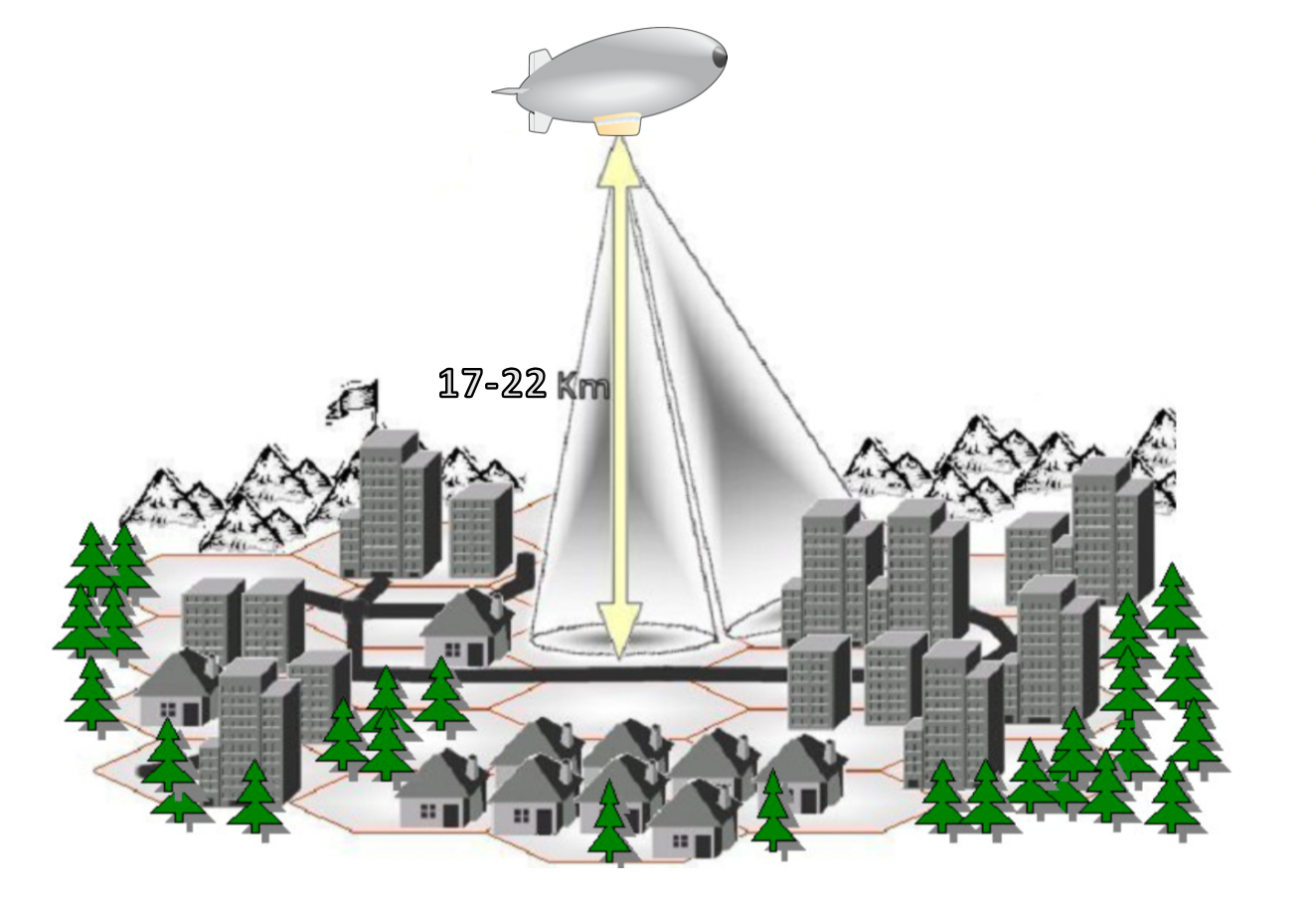
The HAP shown in Figure 1 is equipped with a number of TVWS base stations that provide coverage throughout a geographical region. To cover a radius of 100 kilometers and assuming that each cell is a normal hexagonal cell with a radius (R) of 10.5 kilometer, a payload of 121 TVWS base stations deployed in a hexagonal lattice is needed. The suggested platform’s geometry is seen in Figure 2. Each cell has the ability to provide constant quality of service (64QAM) throughout its coverage area while supporting up to 512 Customer Premises Equipment (CPEs), but this number is heavily dependent on weather conditions due to the need to maintain a fixed-point to multi-point topology [6]. Users on the outside of the service region will encounter a 9.65o elevation angle.
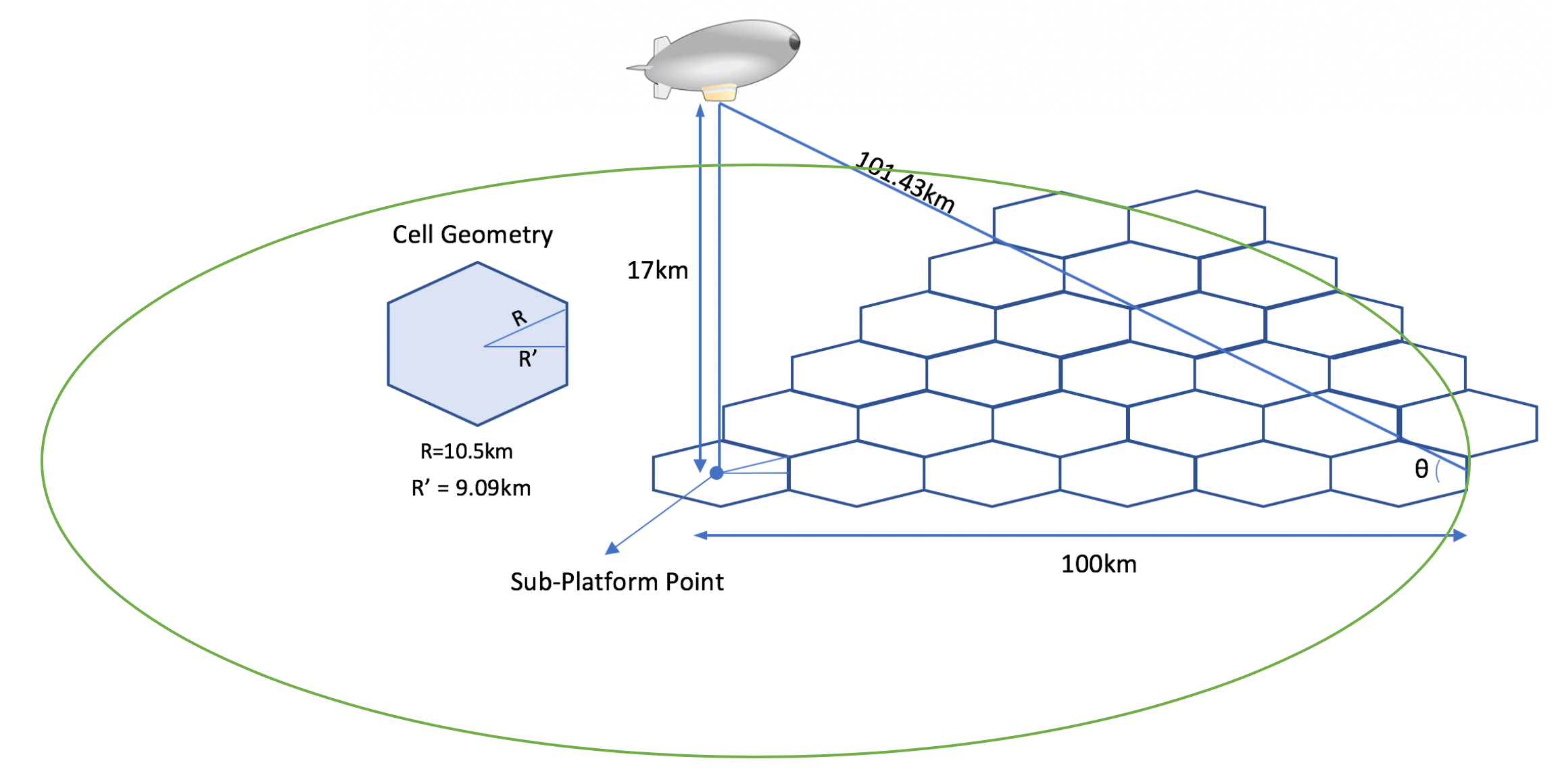
According to the country’s total surface area of roughly 1,104,000km2, Ethiopia would require at least 35 HAPs to offer comprehensive coverage throughout the country. This is dependent on cell / HAP design, population density, and, in some cases, a HAP’s coverage area may be pushed farther to provide additional coverage [6].
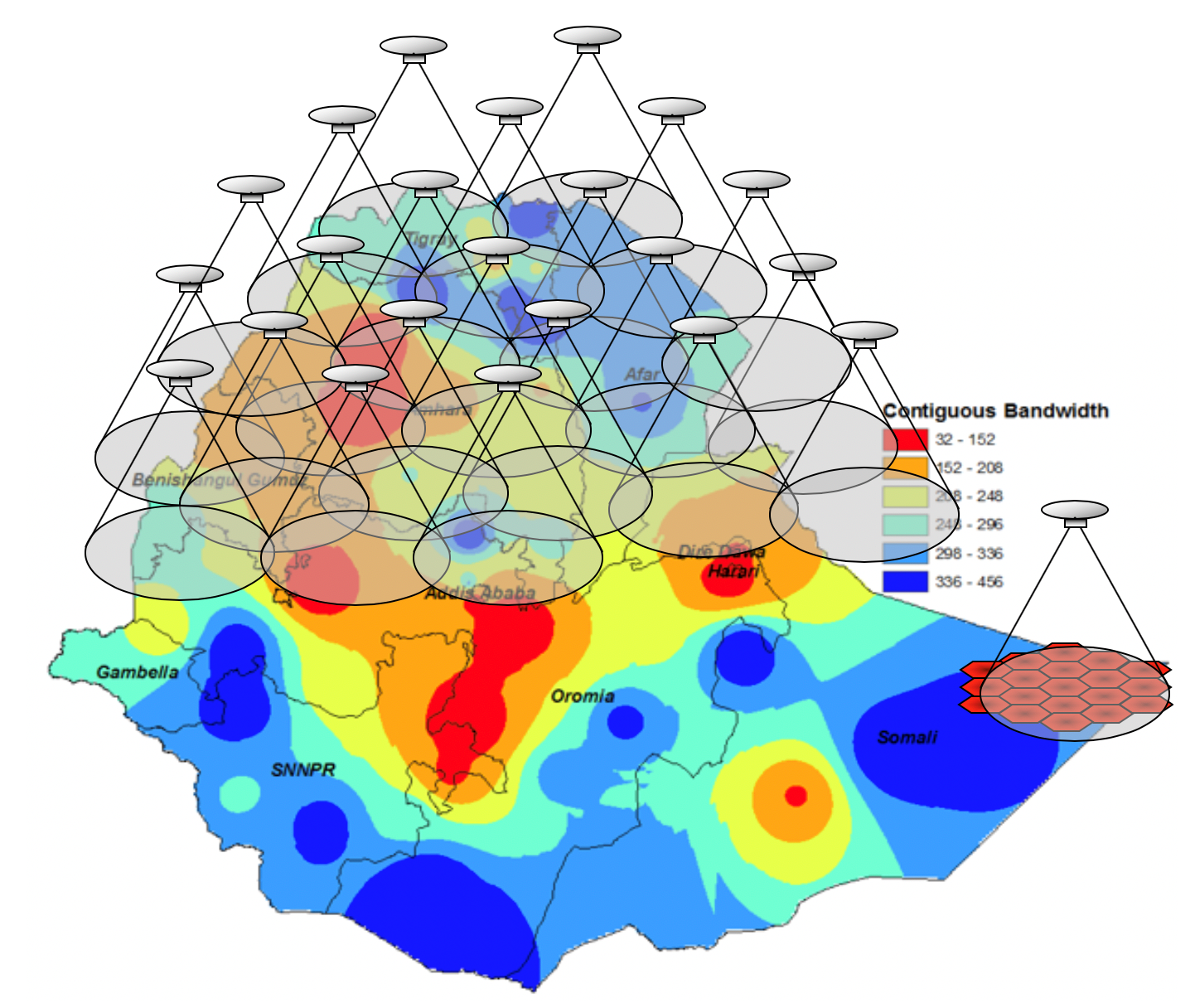
Figure 3 illustrates the fleet of HAPs providing coverage across Ethiopia. The color heat map depicts the amount of free available TVWS spectrums. The figure further illustrates the amount of contiguous TVWS bandwidth.
2.1. Receiver Sensitivity
The Bit Error Rate (BER) for an AWGN channel provides the required SNR values, according to the IEEE 802.22 standard [24] from which the receiver sensitivity may be determined in order to achieve the BER. The minimal input level sensitivity of the receiver may be estimated as follows:
![]()
Where k is Boltzmann’s constant = 1.38×10-23 J/K, T is the receiver’s input absolute temperature = 290 (K), B is the bandwidth (Hz), NF is the receiver’s noise figure (dB), and IL is the implementation loss (dB). For our simulation, we picked a BER of 10-6, which corresponds to the SNR values shown in Table 2.
Table 1: Assumptions for Receiver SNR [6] and [24].
Modulation and Code rate | SNR (dB) |
QPSK½ | 9.4 |
QPSK¾ | 11.2 |
16-QAM½ | 16.4 |
16-QAM¾ | 18.2 |
64-QAM2/3 | 22.7 |
64-QAM¾ | 24.4 |
2.2. Antenna Radiation Pattern
The footprint, coverage, interference, and CIR values are all influenced by the antenna radiation pattern, all of which have a direct impact on the system’s and network’s quality of service and performance. The HAP payload consists of a collection of antennas aimed at various places around the coverage region. Gain is dependent on elevation ( ) and azimuth ( ) angles for each cell [6]. The HAP antenna gain can be obtained as:

Where is the roll-off rate for the HAP antennas. On the other hand, the gain of the user antenna may be mathematically expressed as
![]()
Where is the roll-off rate for the user antennas. The user antenna was designed to be very directional in order to prevent interference from adjacent systems operating on the same frequency.
2.3. System Path Loss
Given that HAPs enable line-of-sight communications, the Free Space Path Loss (FSPL) model is often used to evaluate HAPs systems when the elevation angles are not too tiny. According to [6], FSPL can be determined as

Where d is defined as the distance between the HAP and user, and λ is the wavelength of the message conveying signal.
ITU-R P.452-16 [25] is a prediction model for determining if two stations are interfering. The model is suited to determining the level of interference between stations operating at frequencies ranging from 0.1 to 50 GHz. It is accurate for temporal fractions ranging from 50% to 0.001% using physical models for free space, diffraction, troposcatter, ducting, raised layers, and rain scatter. The advice classifies the route and evaluates the relevance of each propagation mechanism using a path profile. The total pathloss (in decibels) of PL452-16 may be computed as follows:

Here, Clutter Loss (CL) in dB, can be calculated as:

where ![]() (in kilometers) denotes the distance from the notional clutter point to the received antenna,
(in kilometers) denotes the distance from the notional clutter point to the received antenna, ![]() (in meters) denotes the height of the received antenna above the ground, and
(in meters) denotes the height of the received antenna above the ground, and ![]() (in meters) is the nominal clutter point’s height above the ground. may be computed as follows:
(in meters) is the nominal clutter point’s height above the ground. may be computed as follows:
![]()
where ![]() is the operating frequency in gigahertz (GHz). is 0.1 and 0.002 kilometers in rural and urban regions, respectively. The nominal clutter height is ha (in meters) and varies depending on the measuring setting. Its value varies between 4 and 20 meters in rural and urban settings. The total GA in dB is calculated according to ITU.R guideline P.676, which specifies the signal’s attenuation owing to water vapor and dry air [26].
is the operating frequency in gigahertz (GHz). is 0.1 and 0.002 kilometers in rural and urban regions, respectively. The nominal clutter height is ha (in meters) and varies depending on the measuring setting. Its value varies between 4 and 20 meters in rural and urban settings. The total GA in dB is calculated according to ITU.R guideline P.676, which specifies the signal’s attenuation owing to water vapor and dry air [26].
2.4. System Capacity
The availability of each modulation scheme for each cell is directly related to system operating characteristics such as the power of the aerial platform, the receiver’s signal-to-noise ratio, and the available data rate of the channel. These criteria can be used to determine a percentage of availability based on the coverage area of a particular modulation type. Calculate the overall capacity of the aerial platform with cells inside the coverage zone using the formula [6]:

The maximum data rate can be obtained using [6]:

![]()
3. Simulation Result Analysis and Discussion
Our simulation was conducted using the IEEE 802.22 standard [24] and the ITU-R P.452 free space path-loss model[6] and [25]. The HAP is placed at a height of 17 kilometers and is equipped with 121 beams that span a radius of 100 kilometers. Table 1 lists the parameters used in the simulation.
Table 2: Parameters for simulation [6] and [25]
HAP transmitter height (km) | 17 |
Coverage Radius (km) | 100 |
Number of Cells | 121 |
Cell Radius (km) | 10.5 |
Antenna efficiency (%) | 80 |
Boresight gain (dBi) | 20 |
HAP roll-off rate | 3.3 |
User roll-off rate | 58 |
Bandwidth (MHz) | 8 |
Frequency (MHz) | 617 |
NF (dB) | 7 |
IL (dB) | 5 |
Frequency range | 54-862MHz |
Data access technique | DAMA/OFDMA |
Multiplexing method | TDD |
Sampling factor(n) | 8/7 |
Sampling frequency, Fs(MHz) FS=B*n | 9.14 |
FFT size (NFFT) | 2048 |
Using the simulation parameter in Table I, it is possible to determine that the elevation angle, antenna gain, the pathloss, maximum data rate, SNR, and maximum cell and system capacity with and without channel bonding. The data rates associated with various CP factors for the downlink are shown in Table 3 with a channel bandwidth of 8 MHz. According to Table 3, various modulation techniques with CR 1/2 to 5/6 and CP factors ranging from 1/16 to 3/8 produce a range of data speeds in Mbps. For example, QPSK supports data rates ranging from 4.67 to 10.07 Mbps, 16-QAM supports data rates ranging from 9.3415 to 20.15 Mbps, 64-QAM supports data rates ranging from 14.01 to 30.22 Mbps, and 256-QAM supports data rates ranging from 18.68 to 40.29 Mbps. Modulation methods achieved vary according to the location of the Customer Premises Equipment (CPE). When 256-QAM, 5/6 coding rate, and a CP factor of 1/16 are used, the highest data rate achievable is 40.29Mbps, and the maximum spectrum efficiency is 40.29/8=5.04 bits/sec/Hz.
Table 3: TVWS WRAN data rates for various modulation and coding schemes
Modulation | CR | Data rate (MBps) for different CP factor | |||
1/16 | 1/8 | 1/4 | 3/8 | ||
QPSK | 1/2 | 6.05 | 5.71 | 5.14 | 4.67 |
2/3 | 8.06 | 7.61 | 6.85 | 6.23 | |
3/4 | 9.07 | 8.56 | 7.71 | 7.01 | |
5/6 | 10.07 | 9.51 | 8.56 | 7.78 | |
16-QAM | 1/2 | 12.09 | 11.41 | 10.28 | 9.34 |
2/3 | 16.12 | 15.22 | 13.70 | 12.46 | |
3/4 | 18.13 | 17.12 | 15.41 | 14.01 | |
5/6 | 20.15 | 19.03 | 17.13 | 15.57 | |
64-QAM | ½ | 18.13 | 17.13 | 15.41 | 14.01 |
2/3 | 24.16 | 22.83 | 20.55 | 18.68 | |
¾ | 27.20 | 25.69 | 23.12 | 21.02 | |
5/6 | 30.22 | 28.54 | 25.69 | 23.35 | |
256-QAM | ½ | 24.18 | 22.83 | 20.55 | 18.68 |
2/3 | 32.24 | 30.45 | 27.40 | 24.91 | |
¾ | 36.23 | 34.25 | 30.83 | 28.02 | |
5/6 | 40.29 | 38.06 | 34.25 | 31.14 | |
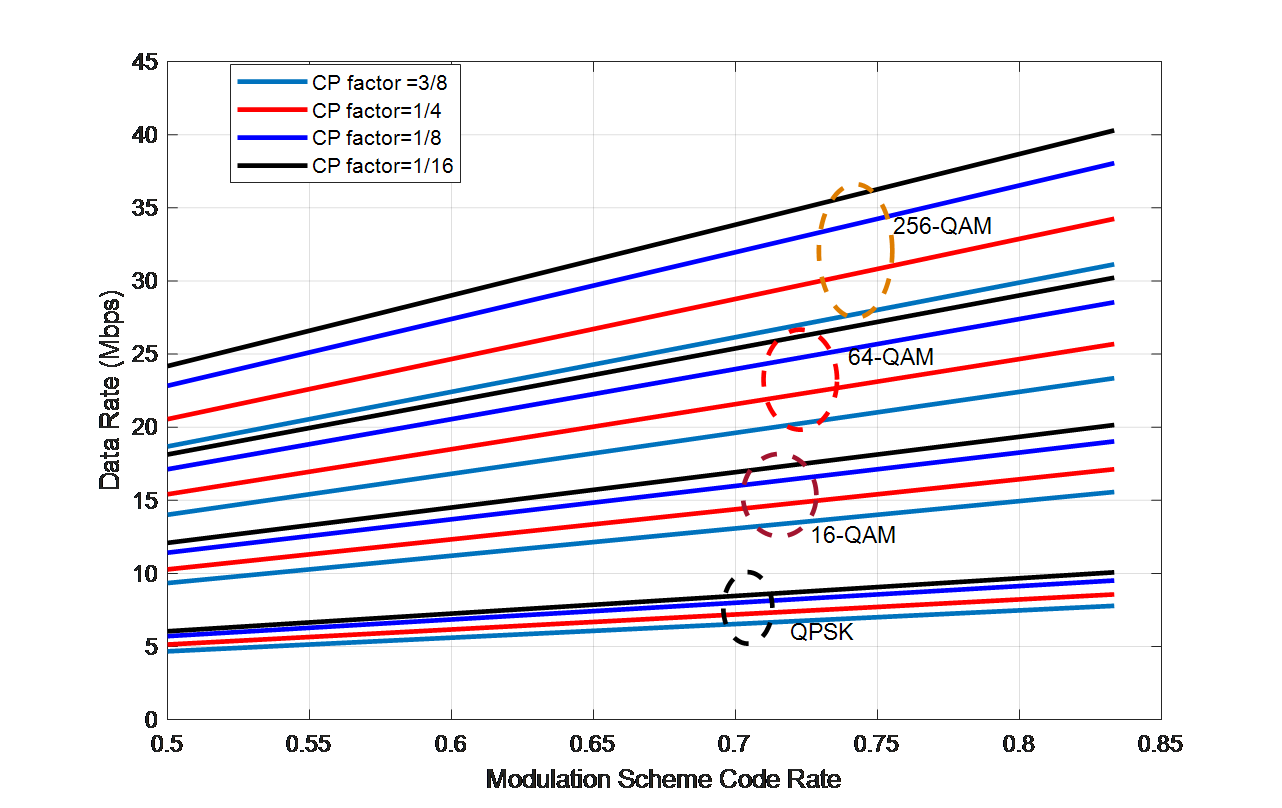
Figure 4 depicts the relationship between data rate and code rate for QPSK, 16-QAM, 64-QAM and 256-QAM at different cyclic prefix factor. As can be seen from Figure 4, the maximum data rate achieved is 40.29 Mbps when 256-QAM, 5/6 code rate, and 1/16 cyclic prefix factor are employed. The minimum data rate is obtained at QPSK, 3/8 CP factor, ½ code rate. Thus, the highest data rate achievable is 30.22Mbps when using 64-QAM and 40.2989 Mbps while using 256-QAM. The elevation angle as a function of distance from the sub platform point is shown in Figure 5. As per the calculation performed the minimum elevation angle at the cell edge is 9.65o as depicted in Figure 5. As a consequence, the angle of departure from the boresight fluctuates, resulting in a reduced antenna gain. As can be seen from Figure 5, as the distance from SPP increases, the elevation angle decreases.
The user antenna should be extremely directional in order to prevent interference from adjacent systems operating on the same frequency as depicted in Figure 6. At 9.65o elevation angle, the user’s antenna gain is 16 dB and the HAP’s gain is 19.34 dB. Figure 7 illustrated, the HAP antenna gain as a function of elevation angle. As can be seen from the figure as the beam width increases, range of the elevation angle increases, however the gain decreases. The decreasing beamwidth resulted in, the increase antenna gain, but the decrease the range of elevation angle.

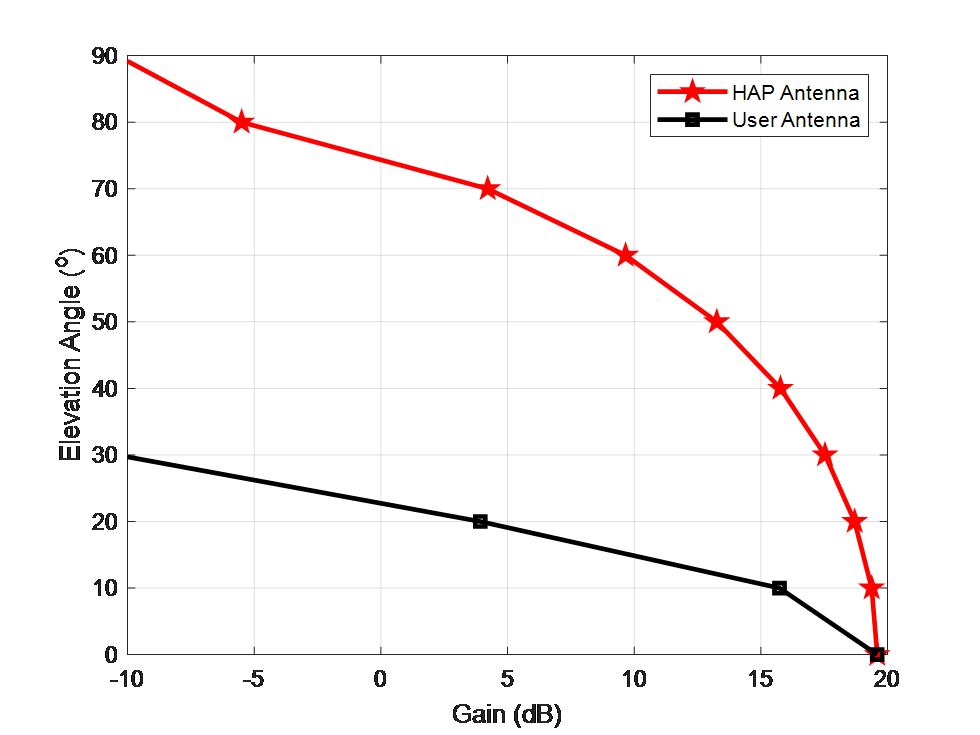

The path loss as a function of the elevation angle is depicted in Figure 8. When the free space route loss is compared to the ITU-R P.452 path loss, the latter reveals a much larger loss, owing to the extra characteristics included, such as diffraction, scattering, and rain attenuation. As can be seen from Figure 8, at 9.65o, ITU-R P.452-16 has a pathloss of 136.87dB and FSPL has a pathloss of 128.30dB.
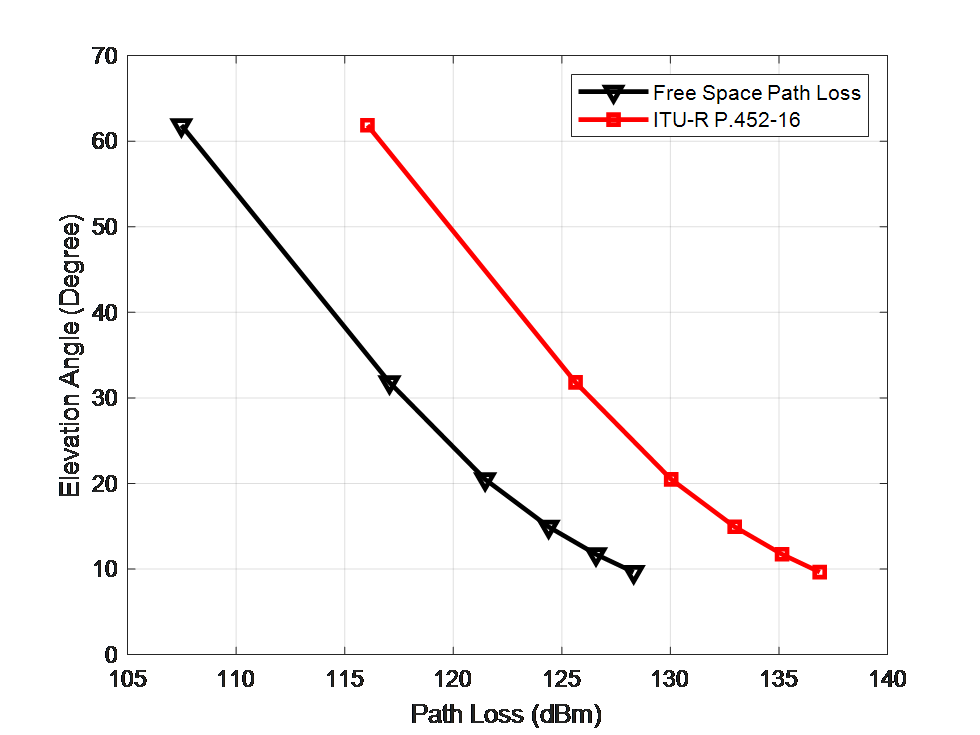
The path loss as a function of the distance from SPP is depicted in Figure 9. When the free space route loss is compared to the ITU-R P.452 path loss, the latter reveals a much larger loss, owing to the extra characteristics included, such as diffraction, scattering, and rain attenuation. As can be seen from Figure 9, at 100km coverage radius, ITU-R P.452-16 has a pathloss of 136.87dB and FSPL has a pathloss of 128.30dB.

Finally, using equation (9), we determined an overall system capacity of 2,734.7Mbps for our TVWS wireless services from HAP system model, which is a possible technique for providing broadband services to a large number of people.
4. 5G Services from HAP exploiting TVWS
Numerous KPIs make it difficult to implement 5G services in rural and low-income communities. Several of these characteristics are discussed in [27]. High-priority applications must be separated from relevant quality of service (QoS) characteristics such as latency and reliability in a 5G network. Prioritization of traffic can be implemented by adjusting resource allocation or pre-empting lower priority traffic. The following KPIs from IMT2020 and 3GPP have been established for the Rural Macro scenario, according to the EU-funded project 5G-MiEdge:
- Downlink data rate: 50Mbps
- Uplink data rate: 25Mbps
- Downlink Area traffic capacity: 1 Gbps/km2
- Uplink Area traffic capacity: 500 Mbps /km2
While a single TVWS HAP system may deliver internet services to rural regions, it may fall short of meeting all of the 5G KPIs for rural areas outlined above. There are many potential solutions to this challenge, including reducing the coverage area, using channel bonding, or even introducing additional platforms [28]. Channel bonding seems to have been thoroughly addressed by a number of writers, for example in [29-32]. According to the IEEE 802.22 PHY/MAC definition [24], the data rate attained with channel bonding by applying equation (10), When three channels are bonded and 256QAM modulation with 5/6 CR, 1/32 CP factor is employed, the data rate computed using (10) is 145.45Mbps. When the same transmission parameters are utilized as in the single channel example, the maximum data rate has increased by 105.15Mbps. Uplink modulation techniques include BPSK, QPSK, 8PSK, 16QAM, and 64QAM. The use of QPSK modulation and a coding rate of 5/6 with a CP factor of 1/16 for uplink channel bonding (of three channels) resulted in a data throughput of 33.3Mbps, satisfying two of the rural 5G KPIs.
5. Conclusions, Challenges and Future Work
By combining the perfect propagation properties of TVWS spectrum with the LoS coverage offered by a HAP, a communication system capable of providing broadband services to rural regions may be created. 121 cells are needed to cover a radius of 100 kilometers. Each cell has a radius of 10.5 kilometers, giving coverage for an area of about 286 kilometers square. According to our findings, each cell is capable of providing 27-40MBps using 64QAM or 256QAM modulation techniques. This may be boosted further by incorporating channel bonding, which enables data transfer speeds of up to 145.45Mbps. To give rural consumers with a 5G experience, however, other strategies will need to be used, such as expanding the number of stations or reducing their coverage area. This, of course, will raise providers’ costs and may dissuade them from constructing such a network in the first place. In this instance, it is more advantageous to establish this sort of network, even if it does not completely fulfill the 5G network’s key performance indicators. This manner, people in rural / low-income regions would be able to access these services while still benefiting from the digital market. Providing TVWS services from HAPs presents a variety of issues. At the present, the most significant problem is platform availability. This may be handled by offering services through aircraft until a commercially accessible unmanned stratospheric platform becomes available (e.g. an airship). Additionally, new low-cost directional antennas are required to enable users to monitor the HAP. This will minimize interference, but they must account for the possibility of HAP migration. Additionally, at this level, the cohabitation of HAP TVWS networks and terrestrial incumbent users must be handled. Additionally, as part of the capacity assessment process, overlap between TVWS cells must be considered. TVWS frequency reuse methods must be used to optimize interference levels between cells and to prevent any detrimental interference to incumbent customers. While delivering wireless service from HAP exploiting TVWS spectrum, managing the interference from incumbent users can be mitigated using phased array antennas. However, HAP interference, induced by comparatively high transmitting power and antenna beam profile, has the ability to greatly impact the current incumbent system on the ground if HAP antenna beams situated are implemented without a proper strategy. Antenna beam pointing techniques utilizing phased array antennas on the HAPs is a challenge. Even though, the stratosphere is comparatively in a stable region, the HAP might face strong wind gusts. As a consequence, the HAP is capable of being oriented in any direction which will resulted in the patterns of received power and interference on the ground (footprints) will continue to move. To mitigate such difficulties, an energy and load aware scheme for maintaining uninterrupted system performance as well as minimizing power consumption is another challenge.
Conflict of Interest
The authors declare no conflict of interest.
- CISCO, Annual Internet Report (2018-2023) Whitepaper,https://www.cisco.com/c/en/us/solutions/collateral/executive-perspectives/annual-internet-report/white-paper-c11-741490.html
- I. T. U. ITU, “ITU releases 2018 global and regional ICT estimates,” International Telecommunication Union, 2018.
- International Telecommunications Union, “ICT facts and figures 2017,” 2017.
- European Commission, “9. Food security , sustainable agriculture and forestry, marine and maritime and inland water research and the bioeconomy,” in Horizon 2020 – Work Programme 2016 – 2017, 2016.
- The World Bank: Ethiopia Digital Foundations Project (P171034), 2016,https://documents.worldbank.org
- K. Katzis, L. Mfupe and H. M. Hussien, “Opportunities and Challenges of Bridging the Digital Divide using 5G enabled High Altitude Platforms and TVWS spectrum,” 2020 IEEE Eighth International Conference on Communications and Networking (ComNet), 2020, pp.
1-7, DOI: 10.1109/ComNet47917.2020.9306090 - H.M. Hussien, k. Katzis , L.P. Mfupe., E.T. Bekele, “Practical Implementation of Geo-location TVWS Database for Ethiopia,” Advances of Science and Technology
(ICAST 2020), vol 385. DOI: 10.1007/978-3-030-80618-7_34. - H. M. Hussien, K. Katzis, L. P. Mfupe and E. T. Bekele, “Coexistence of TV White Space Devices and DTV Services in Ethiopian Geolocation White Space Spectrum Database,” 2019 IEEE 24th International Workshop on Computer Aided Modeling and Design of Communication Links and Networks (CAMAD), 2019, pp. 1-5, DOI: 10.1109/CAMAD.2019.8858472.
- T. T. Terefe et al., “Reserved Distance and Significant Parameter Determination in Incumbent and TV White Space System Coexistence,” ICAST 2020 – 8th EAI Int. Conf. Adv. Sci. Technol.,pp. 125-133, v. 384, 2021, DOI: 10.1007/978-3-030-80621-7_9
- H. Mohammed et al., “Coverage Determination of Incumbent System and Available TV White Space Channels for Secondary Use in Ethiopia,” in IntechOpen, Vision Sensors, 2021, DOI: 10.5772/intechopen.98784.
- H. M. Hussien, K. Katzis, L. P. Mfupe and E. T., “A Novel Resource Allocation for HAP Wireless Networks Exploiting TVWS Spectrum,” 2021 IEEE AFRICON, 2021, pp. 1-6, DOI: 10.1109/AFRICON51333.2021.9570928.
- H. M. Hussien, K. Katzis, L. P. Mfupe and E. T, “Calculation of TVWS Spectrum Availability Using Geo-location White Space Spectrum Database,” 2021 IEEE AFRICON, 2021, pp. 1-6, DOI: 10.1109/AFRICON51333.2021.9570915.
- H. M. Hussien, K. Katzis and L. P. Mfupe, “Dynamic Spectrum Allocation for TVWS Wireless Access from High Altitude Platform,” 2021 International Conference on Electrical, Computer and Energy Technologies (ICECET), 2021, pp. 1-6, DOI: 10.1109/ICECET52533.2021.9698667.
- H. M. Hussien, K. Katzis and L. P. Mfupe, “Intelligent Power Allocation for Cognitive HAP Wireless Networks Using TVWS Spectrum,” 2021 International Conference on Electrical, Computer and Energy Technologies (ICECET), 2021, pp. 1-6, DOI: 10.1109/ICECET52533.2021.9698778.
- J. Thornton, D. Grace, C. Spillard, T. Konefal, and T. C. Tozer, “Broadband communications from a high-altitude platform: The european helinet programme,” Electron. Commun. Eng. J., 2001, DOI: 10.1049/ecej:20010304.
- J. Thornton, D. Grace, M. H. Capstick, and T. C. Tozer, “Optimizing an array of antennas for cellular coverage from a high altitude platform,” IEEE Trans. Wirel. Commun., 2003, DOI: 10.1109/TWC.2003.811052.
- T. Konefal, C. Spillard, and D. Grace, “Site diversity for high-altitude platforms: A method for the prediction of joint site attenuation statistics,” IEE Proc. Microwaves, Antennas Propag., 2002, DOI:10.1019/ip-map:20020107.
- C. L. Spillard, D. Grace, J. Thornton, and T. C. Tozer, “Effect of ground station antenna beamwidth on rain scatter interference in high- altitude platform links,” Electron. Lett., 2002, DOI: 10.1049/el:20020823.
- M. Oodo, R. Miura, T. Hori, T. Morisaki, K. Kashiki, and M. Suzuki, “Sharing and compatibility study between fixed service using high altitude platform stations (HAPS) and other services in the 31/28 GHz bands,” Wirel. Pers. Commun., 2002,DOI: 10.1023/A:1020945122344.
- ITU, “Minimum performance characteristics and operational conditions for High Altitude Platform stations providing IMT-2000 in the Bands 1885-1980MHz, 2010-2025MHz and 2110-2170 in the Regions 1 and 3 and 1885-1980MHz and 2110-2170 MHz in Region 2. – Reccomenda,” 2000.
- J. Lun et al., “Solar Powered High Altitude Platform and Terrestrial Infrastructures,” University of York, White Paper
2017. - Arum et al.,“A review of wireless communication using high-altitude platforms for extended coverage and capacity,” Computer Communications,Volume 157,2020, pp. 232-256, Doi:10.1016/j.comcom.2020.04.020.
- S. Karapantazis and F. Pavlidou, “Broadband communications via high-altitude platforms: a survey,” IEEE Communications Surveys & Tutorials, vol. 7, no. 1, pp. 2–31, 2005, DOI:10.1109/COMST.2005.1423332
- “IEEE Standard for Information technology– Local and metropolitan area networks– Specific requirements– Part 22: Cognitive Wireless RAN Medium Access Control (MAC) and Physical Layer (PHY) specifications: Policies and procedures for operation in the TV ,” IEEE Std 802.22-2011. pp. 1–680, 2011.
- ITU-R, “ITU-R P.452-16,” International Telecommunication Union. 2015.
- ITU-R, “Recommendation ITU-R, P.676-10: Attenuation by atmospheric gases,” P Ser. Radiowave Propag., 2013.
- L. Chiaraviglio et al., “Bringing 5G into Rural and Low-Income Areas: Is It Feasible?,” IEEE Commun. Stand. Mag., 2017, DOI:10.1109/MCOMSTD.2017.1700023
- D. Grace, J. Thornton, G. Chen, G. P. White, and T. C. Tozer,
“Improving the system capacity of broadband services using multiple high-altitude platforms,” IEEE Trans. Wirel. Commun., 2005, DOI: 10.1109/TWC.2004.842972 - J. Elias, F. Martignon, L. Chen, and M. Krunz, “Distributed spectrum management in TV white space networks,” IEEE Transactions on Vehicular Technology, 2017, DOI: 10.1109/TVT.2016.2 597866
- R. Rajbanshi, Q. Chen, A. M. Wyglinski, G. J. Minden, and J. B. Evans, “Quantitative comparison of agile modulation techniques for cognitive radio transceivers,” in 2007 4th Annual IEEE Consumer Communications and Networking Conference, CCNC 2007, DOI: 10.1109/CCNC.2007.230.
- H. Kim and K. G. Shin, “Efficient discovery of spectrum
opportunities with MAC-layer sensing in cognitive radio networks,” IEEE Trans. Mob. Comput., 2008, DOI: 10.1109/TMC.2007.70751. - H. Bogucka, P. Kryszkiewicz, and A. Kliks, “Dynamic spectrum aggregation for future 5G communications,” IEEE Commun. Mag.,2015,DOI: 10.1109/MCOM.2015.7105639.
